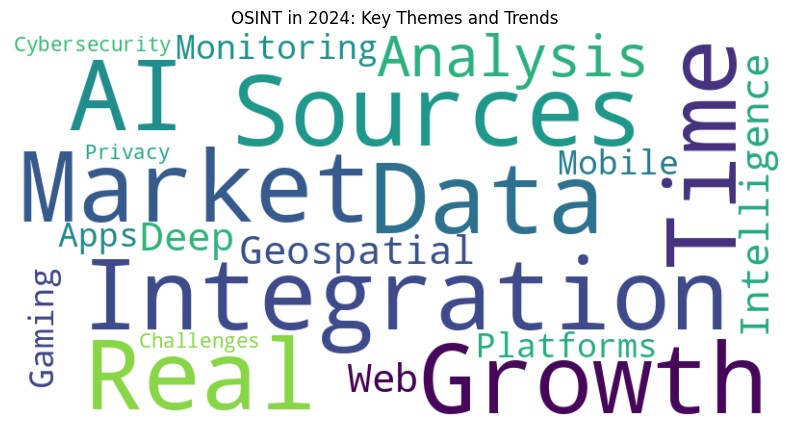Open Source Intelligence in 2024: A Year of Transformation and Growth
The Open Source Intelligence (OSINT) landscape underwent significant changes in 2024, marked by technological advancements, market growth…

The Open Source Intelligence (OSINT) landscape underwent significant changes in 2024, marked by technological advancements, market growth, and evolving strategies. As we are nearing the end of this year, I wanted to recap some of the 2024 developments in the OSINT field that I think are worth mentioning.
Market Growth and Projections
2024 witnessed remarkable growth in the OSINT market. The sector expanded from $12.2 billion in 2023 to $15.15 billion in 2024, representing a compound annual growth rate (CAGR) of 24.2%. Source
This substantial increase was driven by several factors:
- Proliferation of online information
- Advancements in web scraping and crawling technologies
- Rising cybersecurity concerns
- Growing importance of social media data
- AI technologies that continue to make a growing impact on open-source information gathering
The OSINT market is projected to reach $38.07 billion (Source) by 2028, with an expected CAGR of 25.9%. This forecast underscores the increasing relevance and adoption of OSINT across various sectors. This also shows in the number of startups in the OSINT field, be it technological startups or service outfits.
Technological Advancements
AI Integration
As in many other fields and industries, Artificial Intelligence (AI) also emerged as a game-changer in OSINT in 2024. The integration of AI-powered tools significantly enhanced the capabilities of OSINT platforms and information-gathering processes, enabling:
- More efficient data processing and analysis
- Improved pattern recognition
- Enhanced predictive analytics
For instance, Cobwebs, an Israeli open source intelligence provider, who merged with US company PenLink in 2023, introduced an AI-powered OSINT solution that offers crucial information in an easily comprehensible format.

Real-Time Analysis
The ability to conduct real-time OSINT analysis became increasingly important in 2024. This trend was driven by the need for timely intelligence in rapidly evolving situations, such as crisis management and threat detection.
Geospatial Intelligence and Mapping
Geospatial intelligence saw significant advancements, with OSINT tools incorporating more sophisticated mapping capabilities. This development enhanced the ability to visualize and analyze location-based data, crucial for various applications including security and logistics.
Deep and Dark Web Monitoring
As criminal activities increasingly shifted to the deep and dark web, OSINT tools evolved to better monitor these spaces. This trend was particularly notable in cybersecurity and law enforcement applications.
Emerging Data Sources
Mobile Apps
2024 saw a growing recognition of mobile apps as valuable OSINT sources. Apps like Clubhouse, Strava, and Spotify began to be viewed as rich mines of untapped open data. This trend is expected to continue as mobile app usage becomes an integral part of the average digital footprint.
Gaming Platforms
The gaming sphere, with its 3.2 billion players (Source) worldwide, emerged as a new battleground for OSINT. Gaming platforms were recognized not only as sources of valuable data but also as potential venues for activities such as extremist recruitment, financial fraud, and money laundering.
Strategic Developments
U.S. Intelligence Community OSINT Strategy
In March 2024, the Office of the Director of National Intelligence (ODNI) and the Central Intelligence Agency (CIA) released the Intelligence Community (IC) Open Source Intelligence Strategy for 2024–2026. This strategy outlined the IC’s approach to modernizing OSINT collection, creation, and delivery, emphasizing the need to:
- Embrace new technologies and tradecraft
- Enhance collaboration with the private sector and academia
- Develop innovative means to mitigate threats in areas with reduced U.S. influence
Standardization Efforts
In December 2024, the ODNI released new guidance to standardize OSINT discipline and foster partnerships between the Intelligence Community and the private sector. This guidance, titled “ICS 206–01: Sourcing Requirements for Disseminated Analytic Products” established stricter guidelines for citing publicly and commercially available information in analytical products.
Sectoral Adoption and Applications
Law Enforcement
Law enforcement agencies increasingly leveraged OSINT in 2024 for various purposes:
- Criminal investigations
- Trafficking detection
- Dark web marketplace monitoring
The integration of OSINT techniques made these tasks more efficient and effective compared to traditional methods.
Government and Military
Government bodies and military organizations expanded their use of OSINT for:
- Reconnaissance
- Counter-espionage
- Global threat detection
- Sentiment analysis
- Incident response to disasters or civil unrest
- Combating propaganda and misinformation
Corporate Security
As cyber threats continued to evolve, corporate security units increasingly turned to OSINT to:
- Prevent data breaches
- Mitigate reputational risks
- Enhance proactive security measures
Cybersecurity
With global cybercrime costs projected to reach $13.82 trillion by 2028, cybersecurity teams intensified their use of OSINT for:
- Risk assessment
- Threat prevention
- Overall security enhancement
Finance
The financial sector saw increased adoption of OSINT for:
- Fraud detection
- Anti-money laundering efforts
- Market analysis
Challenges and Ethical Considerations
Information Overload
One of the primary challenges in OSINT during 2024 was managing the sheer volume of data. With internet data volume reaching approximately 147 zettabytes (Source), the focus shifted to developing tools and methodologies to extract actionable intelligence from this vast sea of information.
Technical Barriers
The increasing sophistication of OSINT tools and techniques raised concerns about the technical barriers to entry. This challenge highlighted the need for enhanced training and education in OSINT methodologies.
Privacy and Ethical Concerns
As OSINT capabilities expanded, so did concerns about privacy and ethical use of publicly available information. This led to ongoing discussions about the need for guidelines and regulations in OSINT practices.
Tools and Platforms
2024 saw the emergence and refinement of various OSINT tools and platforms. These tools generally fell into three categories:
- Discovery Tools: Basic search tools like Google, which can be powerful starting points for OSINT investigations.
- Scraping Tools: Specialized tools for extracting relevant public data from websites and social media platforms.
- Aggregation Tools: Advanced platforms for combining and analyzing data from multiple sources.
One notable platform that gained prominence was LifeRaft’s Navigator, an advanced OSINT software solution that integrates various OSINT capabilities.
In General, check out this decent list:

Future Outlook
So what’s next? There are several trends that we can expect to have a significant part in shaping the future of OSINT:
- Continued AI and Machine Learning Integration: Further advancements in AI and machine learning are anticipated to enhance OSINT capabilities, particularly in data analysis and pattern recognition.
- Increased Focus on Mobile and Gaming Intelligence: As highlighted earlier, mobile apps and gaming platforms are likely to become more significant sources of OSINT data.
- Enhanced Collaboration: Greater cooperation between public and private sectors in OSINT development and application is expected.
- Ethical and Regulatory Frameworks: The development of comprehensive ethical guidelines and regulatory frameworks for OSINT practices is likely to gain momentum.
- Integration with Cybersecurity Platforms: OSINT tools are expected to become more tightly integrated with cybersecurity platforms, enhancing threat detection and response capabilities.
Final Thoughts
2024 marked a transformative year for Open Source Intelligence. As somebody who has OSINT close to my heart, this was a great year, for the first time it was more likely that somebody knew what OSINT meant when I had a conversation about what I do for a living. The field saw significant market growth, technological advancements, and strategic developments.
From the integration of AI and machine learning to the exploration of new data sources like mobile apps and gaming platforms, OSINT continued to evolve and expand its capabilities and importance. Meanwhile, the adoption of OSINT across various sectors, from law enforcement to finance, demonstrated its versatility and value. However, challenges such as information overload, technical barriers, and ethical concerns remained at the forefront, driving discussions about the future direction of OSINT.
The balance between leveraging the vast potential of open-source data and addressing these challenges will be crucial in shaping the future of intelligence gathering and analysis. The developments of 2024 set the stage for continued innovation and growth in OSINT, promising a future where open-source intelligence plays an increasingly vital role in decision-making processes across public and private sectors alike.
If you like my article, buy me a coffee to keep me going :)

